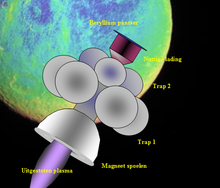Starship
A starship or interstellar spacecraft is a theoretical spacecraft designed for traveling between the stars, as opposed to a vehicle designed for orbital spaceflight or interplanetary travel.
The term is mostly found in science fiction, as humanity has not yet constructed such vehicles (while the Voyager and Pioneer probes have traveled into local interstellar space, they are not generally considered starships because they have not traveled to other stars and also because they are not vessels). However, exploratory engineering has been undertaken on several preliminary designs and feasibility studies for starships that could be built with modern technology or technology thought likely to be available in the near future.
Research

To travel between stars in a reasonable time using rocket-like technology requires very high effective exhaust velocity exhaust jet, and enormous energy to power this, such as might be provided by fusion power or antimatter.
There are very few scientific studies that investigate the issues in building a starship. Some examples of this include:
- Project Orion (1958–1965), mostly manned interplanetary spacecraft
- Project Daedalus (1973–1978), unmanned interstellar probe
- Project Longshot (1987–1988), unmanned interstellar probe
- Project Icarus (2009–2014), unmanned interstellar probe
- Hundred-Year Starship (2011), manned interstellar craft
- See interstellar probes, interstellar travel
The Bussard ramjet is an idea to use nuclear fusion of interstellar gas to provide propulsion.
Other ideas involve going more slowly and building a generation ship, or trying to exceed the speed of light in some way, such as creating and maintaining a wormhole.
Examined in an October 1973 issue of Analog, the Enzmann Starship proposed using a 12,000 ton ball of frozen deuterium to power thermonuclear powered pulse propulsion units.[1] Twice as long as the Empire State Building and assembled in-orbit, the spacecraft was part of a larger project preceded by interstellar probes and telescopic observation of target star systems.[1][2]
The NASA Breakthrough Propulsion Physics Program (1996–2002), was a professional scientific study examining advanced spacecraft propulsion systems.
Fictional types
A common literary device is to posit a faster-than-light propulsion system (such as warp drive) or travel through hyperspace, although some starships may be outfitted for centuries-long journeys of slower-than-light travel. Other designs posit a way to boost the ship to near-lightspeed, allowing relatively "quick" travel (i.e. decades, not centuries) to nearer stars. This results in a general categorization of the kinds of starships:
- Sleeper, which put their passengers into stasis during a long trip.
- Generation, where the destination will be reached by descendants of the original passengers.
- Relativistic, taking advantage of time dilation at close-to-light-speeds, so long trips will seem much shorter (but still take the same amount of time for outside observers).
- Faster-than-light, which can move between places very quickly (transcending current understanding of physics or using interdimensional 'shortcuts').
Fictional elements
Certain common elements are found in most fiction that discusses starships.
Slower-than-light
Fiction that discusses slower-than-light starships is relatively rare, since the time scales are so long. Instead of describing the interaction with the outside world, those fictions tend to focus on setting the whole story within the world of the (often very large) starship during its long travels. Sometimes the starship is a world, in perception or reality.
Faster-than-light
Travel at velocities greater than the speed of light is impossible according to the known laws of physics, although apparent FTL is not excluded by general relativity. An example of a faster-than-light ship is the Enterprise from Star Trek: The Original Series.
Exceptions
- Exceedingly large spacegoing craft (for example the Death Star of the Star Wars universe) are typically not referred to as 'starships' (but see 'slower-than-light ships' above). Terms like (artificial) planetoid may be considered to be more accurate.
- Space stations and other structures intended to orbit a celestial body or serve as a point of contact/maintenance/docking station for other ships are not usually called starships, even if they can move under their own power.
Fictional examples
The following is a listing of some of the most widely known vessels in various science fiction franchises:
Individual ships

- Galactica (Battlestar Galactica)
- Andromeda Ascendant (Andromeda)
- Heart of Gold (Hitchhikers Guide to the Galaxy)
- GSV Sleeper Service (The Culture)
- Liberator (Blake's 7)
- NSEA Protector (Galaxy Quest)
- Jupiter 2 (Lost In Space)
- Red Dwarf (Red Dwarf)
- Scorpio (Blake's 7)
- USS Sulaco (Aliens)
- TARDIS (Doctor Who)
- White Star (Babylon 5)
- Yamato (Space Battleship Yamato/Star Blazers)
- Pillar of Autumn (Halo Series)
- High Charity (Halo Series)
- Axiom (WALL-E)
Groups of ships
- Star Trek ships
- Stargate ships
- Star Wars ships
- Star Destroyer (various)
- X-Wing starfighter (various)
- Millennium Falcon
- Battlestar Galactica ships
See also
- Bioship
- Space travel
- Space battleship
- Spacecraft
- Unidentified flying object (UFO)
References
External links
- CineSpaceships (database of spaceships in movies)
- Starship Dimensions (to-scale size comparisons)
- Starship Size Comparison Chart 1 (Dan Carlson, 13 July 2003)
- Starship Size Comparison Chart 2 (Dan Carlson, 30 October 2003)
- Starship Names (a Sci-Fi wiki article, outside of Wikipedia)
